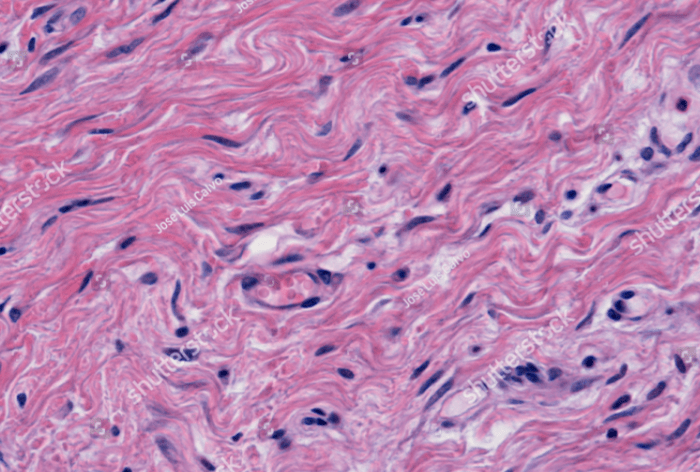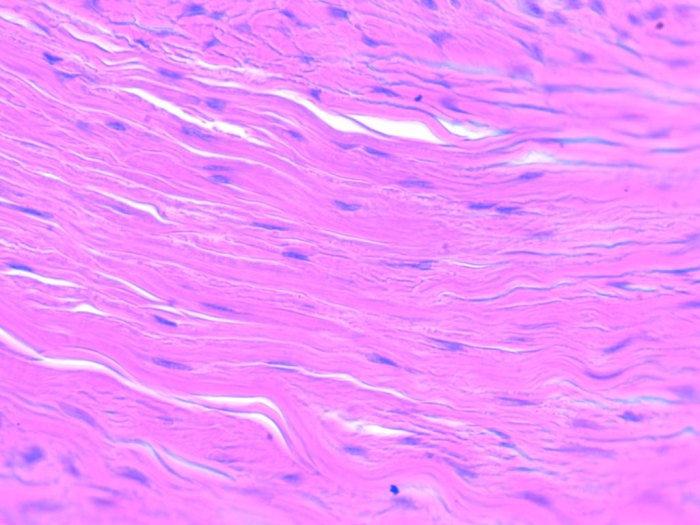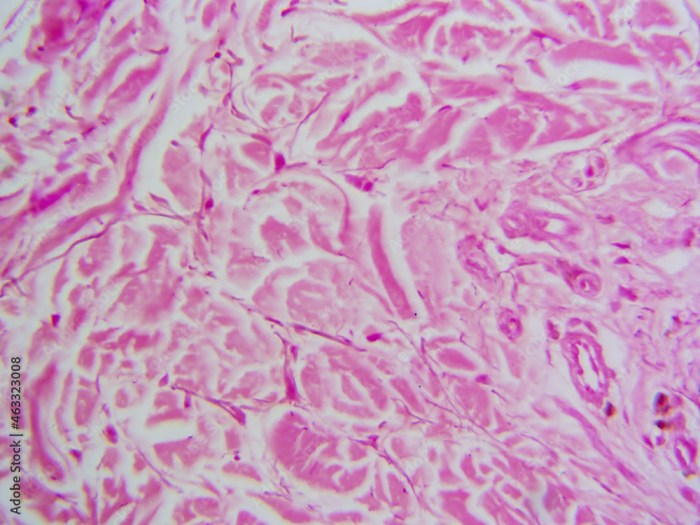Delving into the microscopic realm, the dense irregular connective tissue slide unveils a fascinating world of intricate cellular arrangements and extracellular components. This tissue, characterized by its ubiquitous presence throughout the body, plays a crucial role in providing structural support and facilitating essential physiological processes.
As we embark on this journey of exploration, we will unravel the histological characteristics of dense irregular connective tissue, examining the morphology and function of its diverse cell types. We will delve into the composition and organization of its extracellular matrix, deciphering the interplay between collagen, elastin, and proteoglycans.
Finally, we will explore the distribution and functions of this tissue, highlighting its clinical significance in wound healing, tissue repair, and disease development.
Histological Characteristics

Dense irregular connective tissue appears in a slide as a tightly packed network of collagen fibers arranged in a haphazard manner. These fibers are interwoven and run in multiple directions, giving the tissue its characteristic strength and flexibility.
Arrangement and Orientation of Collagen Fibers
The collagen fibers in dense irregular connective tissue are thick and wavy, forming a dense meshwork that provides structural support to the tissue. The fibers are arranged in bundles that run in different directions, allowing the tissue to withstand forces from various angles.
Presence and Distribution of Cells and Ground Substance
Cells in dense irregular connective tissue are relatively scarce and embedded within the collagen fibers. These cells include fibroblasts, which produce and maintain the collagen matrix, and macrophages, which play a role in tissue defense. Ground substance is present in small amounts and contains glycosaminoglycans and proteoglycans, which help regulate tissue hydration and provide lubrication.
Cell Types: Dense Irregular Connective Tissue Slide

Fibroblasts, Dense irregular connective tissue slide
Fibroblasts are the most abundant cell type in dense irregular connective tissue. They are elongated, spindle-shaped cells with large, oval nuclei. Fibroblasts synthesize and secrete collagen fibers, as well as other components of the extracellular matrix.
Macrophages
Macrophages are large, phagocytic cells that patrol the tissue and remove debris and pathogens. They are important for tissue defense and repair.
Interactions between Cells
Fibroblasts and macrophages interact with each other through cell-cell signaling molecules. These interactions help maintain the structural integrity of the tissue and regulate its response to injury and infection.
Extracellular Matrix

Composition and Organization
The extracellular matrix of dense irregular connective tissue is composed primarily of collagen fibers, elastin fibers, and ground substance. Collagen fibers provide strength and flexibility, while elastin fibers provide elasticity. Ground substance contains glycosaminoglycans and proteoglycans, which regulate tissue hydration and provide lubrication.
Role of Collagen and Elastin
Collagen fibers form a dense network that resists tensile forces, while elastin fibers allow the tissue to stretch and recoil. Together, these fibers provide the tissue with its characteristic strength and flexibility.
Role of Ground Substance
Ground substance helps regulate tissue hydration by attracting and retaining water molecules. It also provides lubrication, reducing friction between adjacent tissues.
Distribution and Functions
Distribution
Dense irregular connective tissue is widely distributed throughout the body, including the skin, tendons, ligaments, and internal organs.
Functions
Dense irregular connective tissue provides structural support, elasticity, and protection to various tissues and organs. In the skin, it provides strength and flexibility, while in tendons and ligaments, it resists forces and prevents overstretching.
Structure-Function Relationship
The haphazard arrangement of collagen fibers in dense irregular connective tissue allows the tissue to withstand forces from various directions. This is important in tissues that are subject to multidirectional stresses, such as the skin and tendons.
Clinical Significance
Wound Healing and Tissue Repair
Dense irregular connective tissue plays a crucial role in wound healing and tissue repair. During the healing process, fibroblasts migrate to the wound site and secrete collagen fibers, which form a scaffold for new tissue growth.
Development of Diseases and Disorders
Alterations in the structure and composition of dense irregular connective tissue can lead to the development of diseases and disorders. For example, excessive collagen deposition can cause scarring, while reduced collagen production can result in tissue weakness and fragility.
Examples
Examples of diseases and disorders associated with alterations in dense irregular connective tissue include keloids, hypertrophic scars, and Ehlers-Danlos syndrome.
Question Bank
What is the primary function of dense irregular connective tissue?
Providing structural support and flexibility to various organs and tissues.
How does the arrangement of collagen fibers contribute to the tissue’s properties?
The irregular arrangement of collagen fibers allows for flexibility and resistance to stretching in multiple directions.
What are the key cell types found in dense irregular connective tissue?
Fibroblasts, macrophages, and mast cells, each with distinct roles in tissue maintenance and repair.